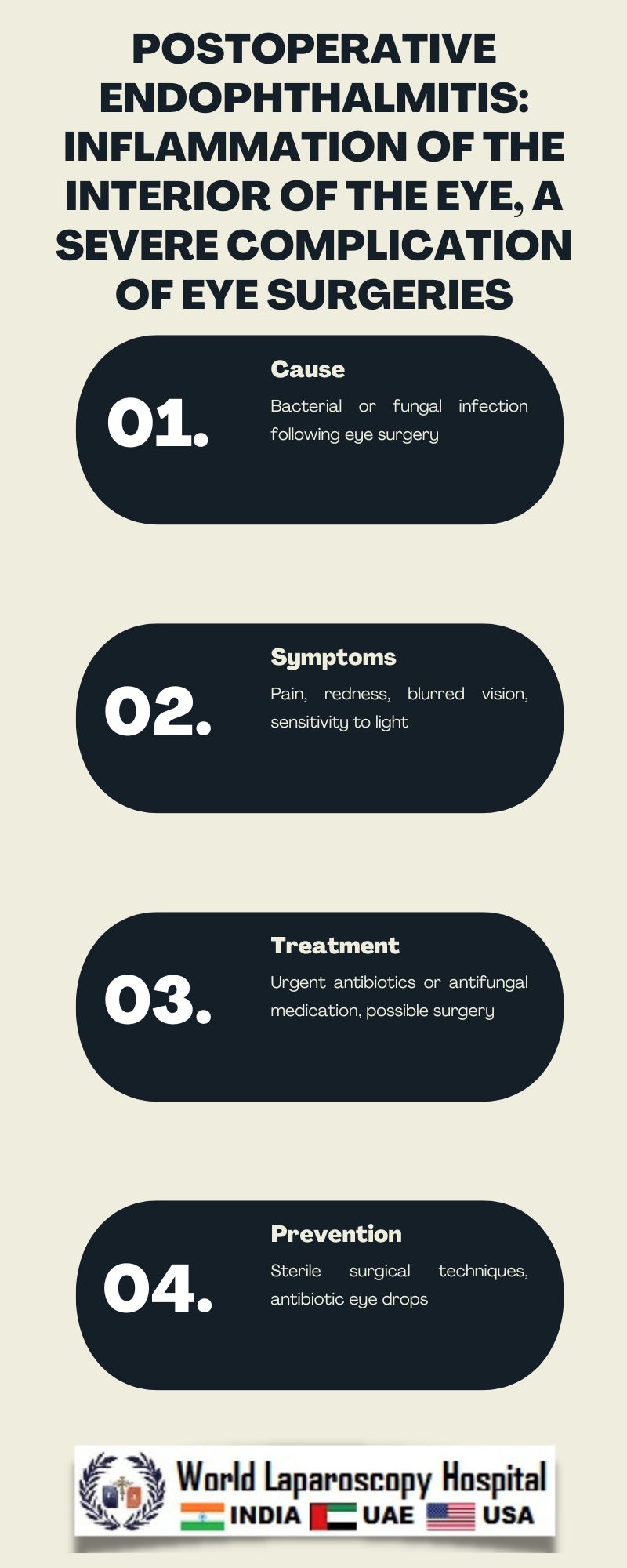Postoperative endophthalmitis: Inflammation of the interior of the eye, a severe complication of eye surgeries
Postoperative endophthalmitis: Inflammation of the interior of the eye, a severe complication of eye surgeries
Introduction
Postoperative endophthalmitis is a rare but serious complication that can occur after eye surgeries, leading to inflammation of the interior of the eye. This condition requires prompt diagnosis and treatment to prevent vision loss and other complications. In this comprehensive guide, we will explore the causes, symptoms, diagnosis, and treatment options for postoperative endophthalmitis.

Causes of Postoperative Endophthalmitis
Postoperative endophthalmitis can be caused by bacterial, fungal, or rarely, viral infections. Bacteria such as Staphylococcus aureus and Streptococcus species are commonly implicated in bacterial endophthalmitis. Fungal endophthalmitis is often associated with Candida species. Viral causes, such as herpes simplex virus, are less common but can also lead to this condition.
Risk Factors
Several factors can increase the risk of developing postoperative endophthalmitis. These include:
Previous eye surgery
Trauma to the eye
Poorly controlled diabetes
Immunosuppression
Inflammatory eye diseases
The use of contaminated intraocular instruments or solutions
Symptoms
Symptoms of postoperative endophthalmitis can vary but often include:
Decreased vision
Eye pain
Redness
Swelling
Sensitivity to light
Floaters
Vision loss
Diagnosis
Diagnosing postoperative endophthalmitis typically involves a thorough eye examination, including visual acuity testing, slit-lamp examination, and intraocular pressure measurement. Additional tests, such as ultrasound or optical coherence tomography, may be used to assess the severity of the condition and guide treatment.
Treatment
Treatment for postoperative endophthalmitis often involves intravitreal injections of antibiotics or antifungal medications to control the infection. In some cases, vitrectomy surgery may be necessary to remove infected vitreous fluid and prevent further damage to the eye. Systemic antibiotics or antifungal medications may also be prescribed to help eliminate the infection.
Prevention
Preventing postoperative endophthalmitis involves strict adherence to sterile surgical techniques, including the use of sterile instruments and solutions. Prophylactic antibiotics may be used before and after surgery in high-risk patients to reduce the risk of infection. Close monitoring of patients after surgery can help detect and treat endophthalmitis early, reducing the risk of vision loss.
Conclusion
Postoperative endophthalmitis is a serious complication that can occur after eye surgeries. Understanding the causes, symptoms, diagnosis, and treatment options for this condition is crucial for preventing vision loss and other complications. By following strict sterile techniques and closely monitoring patients after surgery, healthcare providers can help reduce the risk of postoperative endophthalmitis and improve outcomes for their patients.
Introduction
Postoperative endophthalmitis is a rare but serious complication that can occur after eye surgeries, leading to inflammation of the interior of the eye. This condition requires prompt diagnosis and treatment to prevent vision loss and other complications. In this comprehensive guide, we will explore the causes, symptoms, diagnosis, and treatment options for postoperative endophthalmitis.

Causes of Postoperative Endophthalmitis
Postoperative endophthalmitis can be caused by bacterial, fungal, or rarely, viral infections. Bacteria such as Staphylococcus aureus and Streptococcus species are commonly implicated in bacterial endophthalmitis. Fungal endophthalmitis is often associated with Candida species. Viral causes, such as herpes simplex virus, are less common but can also lead to this condition.
Risk Factors
Several factors can increase the risk of developing postoperative endophthalmitis. These include:
Previous eye surgery
Trauma to the eye
Poorly controlled diabetes
Immunosuppression
Inflammatory eye diseases
The use of contaminated intraocular instruments or solutions
Symptoms
Symptoms of postoperative endophthalmitis can vary but often include:
Decreased vision
Eye pain
Redness
Swelling
Sensitivity to light
Floaters
Vision loss
Diagnosis
Diagnosing postoperative endophthalmitis typically involves a thorough eye examination, including visual acuity testing, slit-lamp examination, and intraocular pressure measurement. Additional tests, such as ultrasound or optical coherence tomography, may be used to assess the severity of the condition and guide treatment.
Treatment
Treatment for postoperative endophthalmitis often involves intravitreal injections of antibiotics or antifungal medications to control the infection. In some cases, vitrectomy surgery may be necessary to remove infected vitreous fluid and prevent further damage to the eye. Systemic antibiotics or antifungal medications may also be prescribed to help eliminate the infection.
Prevention
Preventing postoperative endophthalmitis involves strict adherence to sterile surgical techniques, including the use of sterile instruments and solutions. Prophylactic antibiotics may be used before and after surgery in high-risk patients to reduce the risk of infection. Close monitoring of patients after surgery can help detect and treat endophthalmitis early, reducing the risk of vision loss.
Conclusion
Postoperative endophthalmitis is a serious complication that can occur after eye surgeries. Understanding the causes, symptoms, diagnosis, and treatment options for this condition is crucial for preventing vision loss and other complications. By following strict sterile techniques and closely monitoring patients after surgery, healthcare providers can help reduce the risk of postoperative endophthalmitis and improve outcomes for their patients.
2 COMMENTS
Dr. Suresh Karki
#1
Feb 24th, 2024 6:44 am
Postoperative endophthalmitis, a grave complication of eye surgeries, necessitates thorough comprehension of its causes, symptoms, diagnosis, and treatment to avert vision loss. Adherence to sterile protocols and vigilant post-surgery monitoring are pivotal in reducing risks and enhancing patient outcomes.
Dr. Fulvia Stoneman
#2
Feb 26th, 2024 9:53 am
Postoperative endophthalmitis, a severe eye surgery complication, requires comprehensive understanding for vision preservation. Adhering to stringent sterile techniques and diligent post-surgical monitoring by healthcare providers diminishes risks and enhances patient outcomes effectively.
| Older Post | Home | Newer Post |

